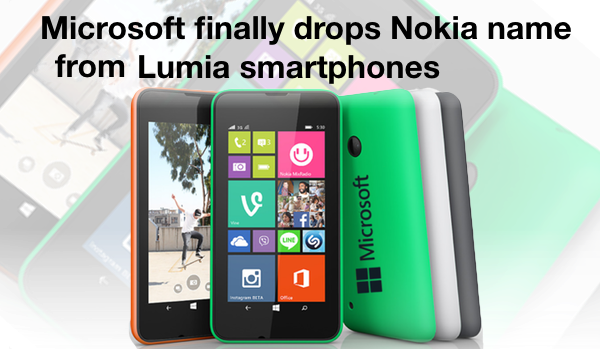Microsoft Lumia ditches the Nokia brand

Nokia Smartphones are dead, long live Microsoft Lumia
It makes a refreshing change to write about Microsoft, Lumia and Windows Phone because it gives us an excuse to scrutinise the latest developments in Redmond’s smartphone business. Understandably, the media pays more attention to Apple and Android these days, while Microsoft plays the underdog with its smartphones inherited from the Nokia acquisition earlier this year.

With the Nokia buyout finalised, it became clear that Microsoft would intended to out the Nokia brand entirely – except for low cost phones such as the Series 30 and Series 40, where it has the right to use the name for ten years. No doubt it wants to capitalise on the incredible brand loyalty for Nokia feature phones in markets such as India and China (Nokia is still the 5th most trusted brand in India according to the Brand Trust Report, by the way).
But last week the inevitable finally happened. Microsoft announced in its latest Conversations blog (“Say Hello to Microsoft Lumia”) that the name would live on as Microsoft Lumia. With their new mobile and cloud-first mantra already in full swing, this is the next step in Microsoft’s mission to grow its smartphone business and actually make third place count for something.
Nokia will be missed
Does is matter that the Nokia Lumia brand is no more? Public opinion is mixed – some have said that “Microsoft Lumia” doesn’t have the same ring to it while others claim it will suffer from association with Microsoft Windows, which admittedly has a public image problem.
Microsoft was founded with the vision of putting a computer in every home and on every desk. With Lumia phones, Microsoft delivers the power of everyday mobile technology to everyone – Tuula Rytilä, SVP of Marketing for Phones at Microsoft
Even many of the comments on Microsoft’s own blog are critical of the rebrand. Regardless, Microsoft needed to make the change swiftly to unify all its devices and services under the same banner.
Nokia as a company still lives on but will focus on other areas such as applications, and hardware and services with its Nokia Solutions and Networks (NSN) division. Interestingly under the Microsoft deal, Nokia is forbidden from competing in smartphones only until 31st of December 2015. Could this mean that one day we might see new Nokia smartphones?
Nokia’s fall from grace
It’s hardly surprise that Nokia’s devices division was sold off, judging by the drastic drop in market share it suffered between 2007 and 2014. It’s also no coincidence that 2007 saw the introduction of the iPhone with Android not far behind, with both making deep inroads into Nokia’s territory.
It was in 2010 that Nokia’s smartphone share fell drastically to 30%, while also being overtaken by Android. Death by a thousand cuts.

Windows Phone still trailing in third place
Fast forward to 2014, and all the new Lumia smartphones will part of the Windows Phone family. While the picture doesn’t exactly look rosy, it’s certainly not bleak either with encouraging sales in several markets and generally positive response to the latest Lumias.
Despite the fact that Windows Phone is doing abysmally in Japan (where Android and iOS almost tie) and is fairly weak on Microsoft’s home turf, it’s a rather different story in Europe with nearly double digit market share in several countries.
Lumia has enjoyed moderate success with some 9.3 million handsets sold in the past year. That figure would be impressive if Apple hadn’t just sold 10 million iPhone 6 devices on the launch weekend alone. Clearly, there is still some way to go…

Microsoft’s bottom line
The Nokia buyout has certainly affected Microsoft’s profits. But last week’s financial results exceeded most analyst estimates with a net income of £2.8 billion for the last quarter on revenues of £14.4 billion. Profit was down 13% from last year, but it was mainly due to the £680 million in “integration and restructuring expenses” – in other words, Nokia.
As part of the restructuring, Microsoft is also laying off more than 18,000 jobs, most of whom are employees that transitioned with Nokia. But Microsoft needn’t start to worry too much just yet, as it’s yearly revenue still tops £53 billion and is on the rise. With solid performance from its other products such as Xbox and Windows 10 on the horizon, there’s still plenty of cash available to promote the Microsoft Lumia brand.

What does the future hold for Microsoft Lumia?
Despite the name change, it doesn’t seem that much will change in the short term – Microsoft is still intent on churning out high quality Lumia phones across all tiers. According to Tuula Rytilä, Microsoft’s SVP of Marketing for Phones, the company will release the first Microsoft-branded Lumia phone soon. No doubt this will be a high end model to make as much impact as possible.
It’s not the hardware that is Microsoft’s problem, it’s how to convince consumers already heavily tied into the Android and iOS ecosystems that it’s worth making the switch to Windows Phone. With the forthcoming Windows 10 desktop operating system, if Microsoft can add compelling features that bring together mobile, desktop and cloud services, it could be a force to be reckoned with in smartphones, but it’s going to be an uphill struggle.
Do you prefer the name Nokia Lumia or Microsoft Lumia? Would you buy a Windows Phone or do you own one already?
Let us know in the comments below.




